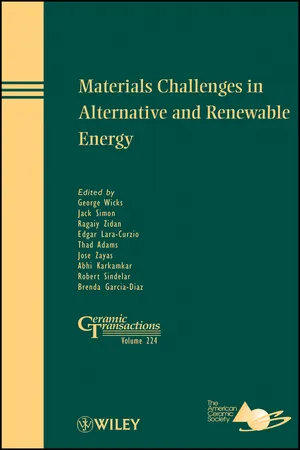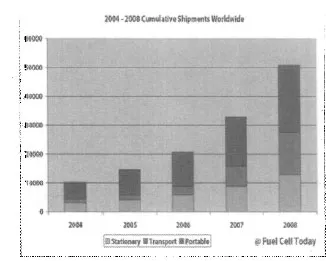
eBook - ePub
Materials Challenges in Alternative and Renewable Energy
- English
- ePUB (mobile friendly)
- Available on iOS & Android
eBook - ePub
Materials Challenges in Alternative and Renewable Energy
About this book
This useful, one-stop resource for understanding the most important issues in materials challenges in alternative and renewable energy. The logically organized and carefully selected articles give insight into materials challenges in alternative renewable energy and incorporate the latest developments related to materials challenges in alternative renewable energy, including hydrogen, batteries and energy storage materials, hydropower, and biomass.
Frequently asked questions
Yes, you can cancel anytime from the Subscription tab in your account settings on the Perlego website. Your subscription will stay active until the end of your current billing period. Learn how to cancel your subscription.
At the moment all of our mobile-responsive ePub books are available to download via the app. Most of our PDFs are also available to download and we're working on making the final remaining ones downloadable now. Learn more here.
Perlego offers two plans: Essential and Complete
- Essential is ideal for learners and professionals who enjoy exploring a wide range of subjects. Access the Essential Library with 800,000+ trusted titles and best-sellers across business, personal growth, and the humanities. Includes unlimited reading time and Standard Read Aloud voice.
- Complete: Perfect for advanced learners and researchers needing full, unrestricted access. Unlock 1.4M+ books across hundreds of subjects, including academic and specialized titles. The Complete Plan also includes advanced features like Premium Read Aloud and Research Assistant.
We are an online textbook subscription service, where you can get access to an entire online library for less than the price of a single book per month. With over 1 million books across 1000+ topics, we’ve got you covered! Learn more here.
Look out for the read-aloud symbol on your next book to see if you can listen to it. The read-aloud tool reads text aloud for you, highlighting the text as it is being read. You can pause it, speed it up and slow it down. Learn more here.
Yes! You can use the Perlego app on both iOS or Android devices to read anytime, anywhere — even offline. Perfect for commutes or when you’re on the go.
Please note we cannot support devices running on iOS 13 and Android 7 or earlier. Learn more about using the app.
Please note we cannot support devices running on iOS 13 and Android 7 or earlier. Learn more about using the app.
Yes, you can access Materials Challenges in Alternative and Renewable Energy by George Wicks, Jack Simon, Ragaiy Zidan, Edgar Lara-Curzio, Thad Adams, Jose Zayas, Abhi Karkamkar, Robert Sindelar, Brenda Garcia-Diaz, George Wicks,Jack Simon,Ragaiy Zidan,Edgar Lara-Curzio,Thad Adams,Jose Zayas,Abhi Karkamkar,Robert Sindelar,Brenda Garcia-Diaz in PDF and/or ePUB format, as well as other popular books in Technology & Engineering & Materials Science. We have over one million books available in our catalogue for you to explore.
Information
HYDROGEN
HYDROGEN STORAGE TECHNOLOGIES – A TUTORIAL WITH PERSPECTIVES FROM THE US NATIONAL PROGRAM
ABSTRACT
While the demand for electrical power generated by clean, efficient hydrogen fuel cells is rapidly growing, one of the key technical issues that remains to be resolved is the storage of hydrogen, or hydrogen-bearing fuels, to be available to the fuel cell within the design and performance constraints of the total power system. Criteria such as hydrogen storage capacity, weight, volume, lifetime and cycle-life, and certainly cost, become important factors in determining the best storage system for a particular application. In this paper we review the various storage approaches that are currently under investigation and provide a brief materials science tutorial on the storage mechanism for each approach.
Physical storage approaches store hydrogen as a compressed gas, a cryogenic liquid or as a cryo-compressed gas. Materials-based storage systems are based on storing hydrogen by adsorption, absorption or chemical bonding to various materials such as reversible or regenerable hydrides. Each of these storage systems will be discussed and the particular materials science challenges involved will be noted. At the present time no hydrogen storage approach meets all volume, weight and cost requirements for automotive fuel cell power systems across the full range of vehicle platforms. It is clear that materials science will play a key role in the ultimate solution of the hydrogen storage challenge.
INTRODUCTION
Hydrogen fuel cells are emerging as a leading candidate in the search for a clean, efficient alternate energy source. Fuel cells fueled with hydrogen are coming out of the Laboratory and moving toward commercialization in a variety of important applications. Initially fuel cells provided high-value power for both manned and unmanned spacecraft, but more recently they are being developed for “down to earth” applications such as back-up power for telecommunications and uninterrupted power systems (UPS), stationary power for residential, commercial and industrial uses, and portable power for hand-held instrumentation and military applications. Longer term transportation deployments are targeted toward the personal automobile market with specialty vehicles (e.g., forklifts), transit buses, and fleet vehicles leading with early market entry. In 2008 world-wide cumulative shipments of fuel cells exceeded 50,000 units (see Figure 1).
Figure 1. Worldwide Cumulative Fuel Cell Shipments. (Source Fuel Cells Today)

As hydrogen fuel cells become a viable contender in the alternative energy arena, attention is being focused on overcoming the major technical challenges that may ultimately impact introduction in potential early markets. For example, fuel cell cost is a significant factor that must be addressed for this technology to be competitive with conventional, petroleum-based power systems. Likewise the availability of hydrogen to fuel the system is a technical challenge. For the ultimate transportation application – the consumer automobile – a sufficient amount of hydrogen must be stored on-board the vehicle to allow a 300-mile driving range.
Hydrogen continues to receive intense study and support as a leading candidate to provide clean, safe and efficient power as an alternative to petroleum/hydrocarbon sources. Like all potential fuels hydrogen has both advantages and disadvantages. It is the lightest of all the elements. Based on its lower heating value (LHV) hydrogen has a very attractive specific energy of 120 kJ/g or 33.3 kWh/kg – approximately three times that of gasoline. Of course, with a normal boiling point of 20 K, hydrogen is a gas in its normal state with a density of ~0.09 g/L or 11 L/g. So while hydrogen has a high specific energy, due to its low density it has a normal energy density of only 10 kJ/L compared to gasoline at ~32,000 kJ/L. Therefore the challenge for hydrogen storage is to increase its normal energy density, thus it is normally stored either at high pressure or as a cryogenic liquid. Its storage is further problematic due to its ability to diffuse through many containment materials and can cause embrittlement, resulting in diminished material strength and lifetime challenges. On the other hand hydrogen combustion products from fuel cells are only water and heat making it a non-polluting energy carrier. Additionally hydrogen can be derived from various liquid fuels that can be reformed either internally within or externally to the fuel cell, and it can also be produced using alternative energy sources (such as solar, wind, nuclear, etc.).
The U.S. Department of Energy has identified several key characteristics for viable hydrogen storage systems. Key storage system characteristics include: gravimetric and volumetric capacities (i.e. system weight and volume per unit H2); operating temperature and pressure; transient response (startup and shut-down times and load following); refill time; dormancy (i.e. length of idle time before H2 loss occurs); cycle life and costs (capital, maintenance and refueling). The actual values of these characteristics will vary depending on the specific needs of the particular application. However the most challenging requirements, by far, are those for the ≥300-mile range, on-board hydrogen storage system for automobiles. A complete list of the DOE system performance targets for vehicular, onboard hydrogen storage can be found on the DOE website.1 The performance targets are system targets and must be achieved simultaneously. Presently extensive research, development and testing are underway to address the challenge of hydrogen storage for fuel cell power systems. Material science is the key to the long-term development of practical hydrogen storage systems that meet the established performance and cost targets. Hydrogen storage concepts are based on physical storage systems and materials-based approaches; each is summarized in the following sections of this paper.
PHYSICAL STORAGE
Physical storage techniques generally involve storing hydrogen as a compressed gas or as a cryogenic liquid in a qualified container. High pressure storage vessels are the present state-of-the-art in hydrogen storage. Most commercially available fuel cell power systems operate on high pressure compressed hydrogen stored in certified tanks. Storage at cryogenic temperatures allows hydrogen to be stored at liquid densities and cryo-compressed storage concepts attempts to take advantage of both high pressure and cryogenic temperatures.
Compressed Storage
For compressed gas storage the higher the pressure the higher the density of stored gas. While merchant hydrogen is typically delivered for industrial uses in the pressure range from 150 to 250 bar, automotive storage systems commonly operate at 350 bar with the goal of increasing the operating pressure to 700 bar. Clearly for on-board storage the higher the pressure the greater quantity of hydrogen that can be contained in a fixed volume. However as the pressure increases the cost and weight of the storage tank increases and ultimately a point of diminishing returns is reached. The walls of all-metal storage tanks (Type I) must contain all of the stress from the high pressure, thus the wall thickness of the containment vessel increases rapidly with pressure. Since the wall thickness relates to the operating pressure and ultimate tensile and yield strength of the metal, higher strength metals could lead to lighter cylinders, however current standards and regulations limit the ultimate tensile strength of steels used in hydrogen service to 950 MPa due to hydrogen embrittlement issues.2 The materials R&D challenges for all-metal hydrogen storage cylinders therefore include the development of high strength metals that are not susceptible to hydrogen embrittlement. In addition there is a need to more fully understand cycle fatigue failure under hydrogen storage operating conditions.
Fiber reinforced composite cylinders are also being developed for hydrogen storage. These include hoop-wrapped (Type II) and fully wrapped with either metal liners (Type III) or non-metal liners (Type IV). These composite tanks can either share the strain load between the liner and fiber layers (Type II and III) or have the fiber layer fully bear the strain load (Type IV). Composite cylinders generally allow higher pressure operation resulting in higher gravimetric capacities (>5 wt.%) compared to more conventional T...
Table of contents
- Cover
- Half Title page
- Title page
- Copyright page
- Preface
- Acknowledgments
- Hydrogen
- Batteries and Energy Storage Materials
- Solar
- Hydropower
- Nuclear
- Wind
- Biomass
- Geothermal
- Author Index